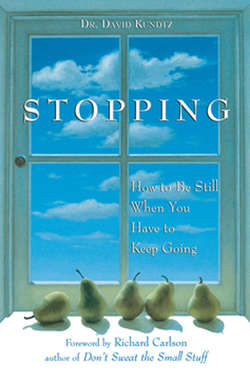Читать книгу Stopping - David Kundtz - Страница 9
На сайте Литреса книга снята с продажи.
ОглавлениеNo matter how fast we go,no matter how many comforts we forgo . . .there never seems to be enough time.
JAY WALLJASPER
2
Why Cramming and Cutting Don't Work
In the past, we used two ways of coping with the challenge of too much: We crammed things in or we cut things out. These are natural, normal, and effective responses to life at a certain pace.
Cramming is trying to fit more and more into the same, limited time and space using the same, limited energy and stamina. Until the pile of rocks changed into the Mountain of Too Much, cramming worked just fine: We became more efficient and more productive. We learned to manage our time better, to move faster, and to sprint through our day without pausing for breath. But that was before we reached the critical mass of too much. Now it causes us to be overwhelmed and stuffed to overfull; thus, we are left frustrated and feeling like we have no room left for ourselves. Whenever I feel this stuffed feeling, I often show it through moodiness, irritability, and spiritual malaise.
Think of packing your suitcase. Have you ever tried to cram things in? You cram and cram and even resort to sitting on it to force it closed, but there is a moment when, with just one more pair of socks, the suitcase will not close. And even if we manage to jam the suitcase shut, we may rip its seams or risk it popping open in midflight. Think of yourself as that suitcase: Your seams are ripping and your emotional insides are bursting out and spilling into the middle of your day. That's the point we're at. Cramming no longer works. There is simply too much to fit in.
Cutting out is excluding things from our lives to make more room for new demands. We become good at prioritizing: We drop old friends to make room for taking our kids to soccer, we eliminate lunch to get a little more work done, we cut short our days off to catch up on a report, and we wake up an hour early to have time for exercise. But this works only to a certain point. Finally, you can cut out no more. You get down to the essentials: work, personal responsibilities, and a necessary amount of sleep and social time. When demands from work or family crises intervene, leisure time, exercise, social life, and days off go out the window. Finally, there comes a time when there is nothing to cut and still too much to do. Our health—mental and physical—suffers. We voice the complaint that I hear most often in my seminars on stress: We feel as though we are moving through life, but not actually experiencing it. As you probably know from your own life, cutting just no longer works.
The Mountain of Too Much is new and therefore calls for new skills. It's long past the time to let go of these once-effective responses. They are ineffective habits of behavior. They are also a form of denial, that which is a lack of awareness of a situation too painful or disturbing to acknowledge in this case the problem of too much. Besides being futile, these habits are robbing us of the pleasure of life.
But there is something new that you can learn to do. I call it Stopping.
